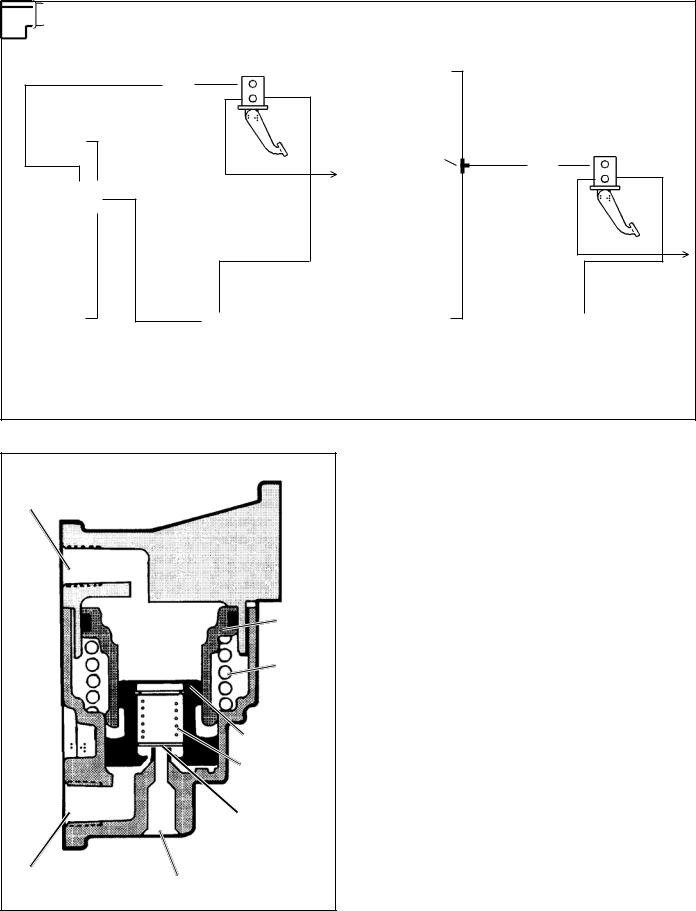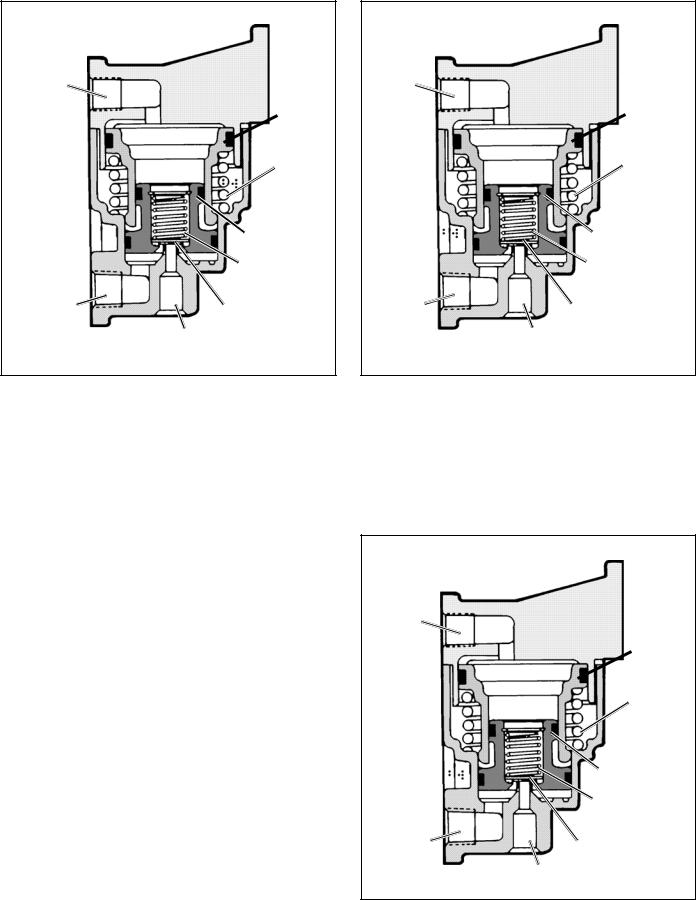Bendix LQ-3 LQ-4 FRONT AXLE RATIO VALVE User Manual

®
 SD-03-951
SD-03-951
Bendix® LQ-3™ & LQ-4™ * Front Axle Ratio Valve
1/4" NPT |
3/8" NPT |
|
 PISTON SPRING
PISTON SPRING
INLET EXHAUST
VALVE SPRING
 LOWER PISTON
LOWER PISTON 
ASSEMBLY
1/4" NPT |
3/8" NPT |
|
HOLD OFF |
|
SPRING |
|
(WHEN REQUIRED) |
LQ-3™ FRONT AXLE RATIO VALVE |
LQ-4™ FRONT AXLE RATIO VALVE* |
(*THE LQ-4™ VALVE'S OPERATION IS IDENTICAL TO THE LQ-3™ VALVE. INTERNAL CONFIGURATION IS SLIGHTLY DIFFERENT.)
FIGURE 1 - LQ-3™ AND LQ-4™ FRONT AXLE RATIO VALVE
FUNCTION AND DESCRIPTION
The LQ-3™ and LQ-4™ front axle ratio valve is used on the front or steering axle of a vehicle to limit the brake application pressure to the actuators during normal service braking. Limiting application pressure reduces the braking effort at the foundation brakes on the steering axle. The supply and delivery ports in both the LQ-3™ and LQ-4™ valves are identified with embossed lettering. The ports in the LQ-3™ valve are 1/4 inch N.P.T. and in the LQ-4™ valve, 3/8 inch N.P.T. The exhaust port is not threaded in either valve. Two mounting holes are provided for 5/16 inch mounting bolts. Note: When mounted on the vehicle the exhaust port should be pointed down.
GENERAL OPERATION
The supply port of the LQ-3™ or LQ-4™ valve is connected to the delivery port of the service brake valve. The delivery port of the LQ-3™ valve is connected to the service port of the front axle relay valve or the adaptive braking modulator. The LQ-4™ valve may be used to operate brake chambers up to Type 24 without relay or QRV.
Pressure delivered to the LQ supply port is reduced by 50% as it passes through the valve and out the delivery port. The 50% reduction occurs only when brake application pressure
LQ-3™ FRONT AXLE RATIO VALVE
EXTERIOR
to the supply port of the LQ is between 0 psi and 40 psi. Brake applications between 40 psi and 60 psi to the LQ supply port are reduced by less than 50% and applications above 60 psi are not reduced at all. An example would be: 65 psi delivered to the supply port results in 65 psi out the LQ delivery port.
1

|
E-6™/E-7™ |
BRAKE |
|
|
CHAMBER |
|
|
|
BRAKE |
|
|
|
|
|
|
|
VALVE |
|
|
BRAKE |
|
|
|
CHAMBER |
LQ-3™ |
|
E-6™/E-7™ |
|
VALVE |
|
BRAKE |
|
|
TEE |
VALVE |
|
|
|
|
|
|
|
LQ-4™ |
MODULATOR |
|
|
VALVE |
|
|
|
|
OR RELAY |
|
|
|
VALVE |
|
|
|
BRAKE |
RESERVOIR |
BRAKE |
RESERVOIR |
CHAMBER |
|
CHAMBER |
|
TYPICAL LQ-3™ FRONT AXLE RATIO VALVE INSTALLATION |
TYPICAL LQ-4™ FRONT AXLE RATIO VALVE INSTALLATION |
||
FIGURE 2 - TYPICAL INSTALLATIONS
SUPPLY
OUTER
PISTON
OUTER
PISTON
RETURN
SPRING
INNER PISTON
INLET & EXHAUST
VALVE RETURN
SPRING
INLET & EXHAUST
VALVE
DELIVERY |
EXHAUST |
FIGURE 3 - LQ-3™ * BRAKE VALVE APPLICATION: 0-40 PSI
(*LQ-4™ VALVE OPERATION SAME AS LQ-3™ VALVE.)
2
Note: The pressures used here are examples only. Both the LQ-3™ and LQ-4™ valves may have been supplied with initial hold-off pressures of either 4 psi or 10 psi and equalization pressures of 60 or 65 psi respectively depending upon the vehicle installation and manufacturer’s specification. The LQ-3™ valve hold-off pressure depends on the inlet-exhaust valve spring installed. The LQ-4™ valve by whether or not a hold-off spring is installed under the lower piston.
OPERATION — BRAKE APPLICATION OF 40 PSI OR LESS
When a service brake application of less than 40 psi is made, application air enters the LQ valve supply port and exerts a force over the surfaces of the outer and inner pistons. Because of the spring force beneath the outer piston, only the inner piston moves. The initial delivery of air from the brake valve forces the inner piston all the way down as shown in Figure 3. Delivery pressure builds up under the inner piston as shown in Figure 4 and as explained under
Operation — Balanced.
OPERATION — BALANCED
Air pressure present at the delivery port of the LQ-3™ or LQ-4™ valve is also present beneath the inner piston. When the air pressure acting on the underside of the inner piston is approximately half of the brake valve delivered pressure, the piston lifts, closing the inlet. The exhaust remains closed. (See Figure 4.)

SUPPLY
OUTER
 PISTON
PISTON
OUTER
PISTON
RETURN
SPRING
INNER PISTON
INLET & EXHAUST
VALVE RETURN
SPRING
DELIVERY
INLET & EXHAUST EXHAUST VALVE
FIGURE 4 - LQ-3™ FRONT AXLE RATIO VALVE*
BALANCED BRAKE VALVE APPLICATION AT 40 PSI OR LESS. (*LQ-4™ VALVE OPERATION SAME AS LQ-3™ VALVE.)
Note: The top surface of the inner piston has approximately one half of the area of the lower surface of the inner piston. Air pressure acting on the top surface of the inner piston exerts a force one half as great as the same air pressure acting on the lower surface. Therefore, to balance the piston, (both inlet and exhaust closed) the pressure beneath the inner piston may be 1/2 that above it. An example would be: 30 psi delivered to the supply port and acting on the top surface of the inner piston would result in approximately 15 psi at the delivery port and acting on the lower surface.
OPERATION — EXHAUST
When the service brake application is released, the air above the inner piston of the LQ valve returns to the brake valve and is exhausted. The air pressure at the delivery port of the LQ valve acts on the underside of the inner piston and lifts it, which unseats the exhaust valve. (See Figure 5.) The delivery volume air exhausts both through the brake valve and out the exhaust port.
OPERATION — SERVICE BRAKE APPLICATION 40 PSI OR GREATER
When a service brake application of greater than 40 psi is made, air entering the supply port forces the outer piston into contact with the inner piston against the resistance of the outer piston return spring. Both the outer and inner pistons now move as one. Because of the added surface area of the outer piston, delivery pressure from the LQ valve will
SUPPLY
OUTER
 PISTON
PISTON
OUTER
PISTON
RETURN
SPRING
INNER PISTON
INLET & EXHAUST
VALVE RETURN
SPRING
DELIVERY
INLET & EXHAUST EXHAUST VALVE
FIGURE 5 - LQ-3™ FRONT AXLE RATIO VALVE* EXHAUST.
(*LQ-4™ VALVE OPERATION SAME AS LQ-3™ VALVE.)
“catch up” at the rate of 2:1 as supply pressure increases from 40-60 psi. An example would be: a brake application of 50 psi would result in delivery pressure of 40 psi. For service applications of 60 psi or greater the LQ valve does not reduce delivery pressure. (See Figure 6.)
SUPPLY
OUTER
 PISTON
PISTON
OUTER
PISTON
RETURN
SPRING
INNER PISTON
INLET & EXHAUST
VALVE RETURN
SPRING
DELIVERY
INLET & EXHAUST EXHAUST VALVE
FIGURE 6 - LQ-3™ FRONT AXLE RATIO VALVE* BRAKE
VALVE APPLICATION AT 60 PSI OR GREATER. (*LQ-4™ VALVE OPERATION SAME AS LQ-3™ VALVE.)
3
